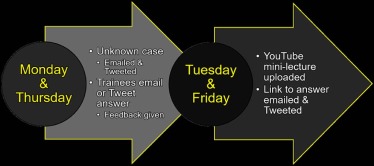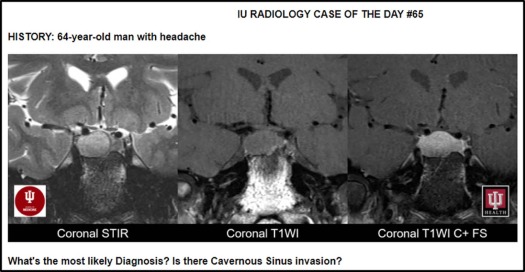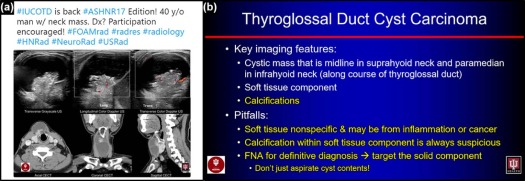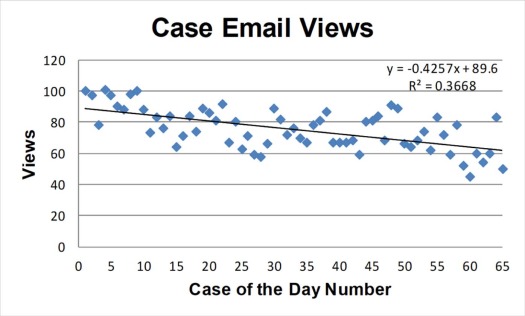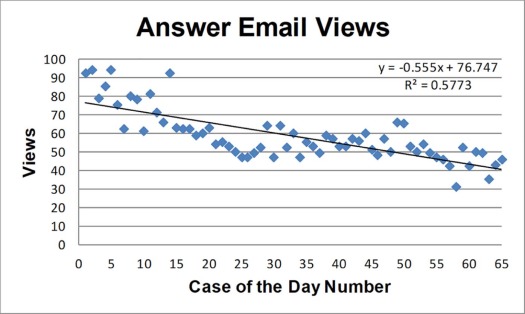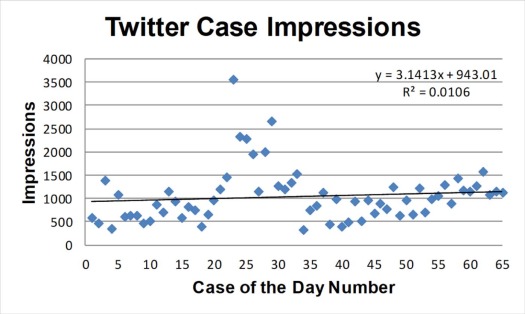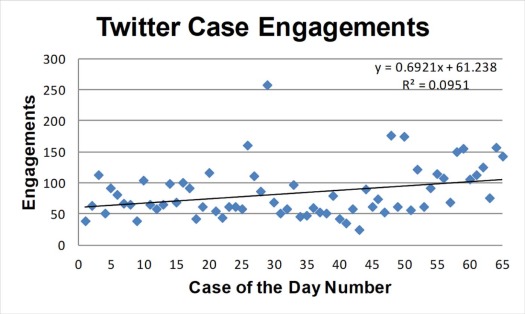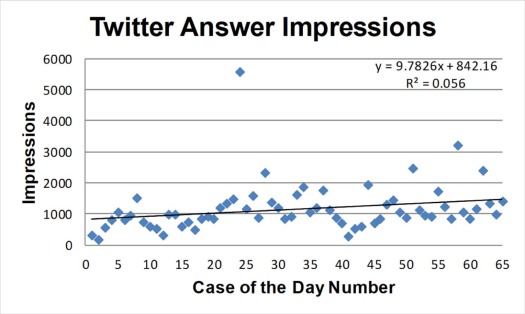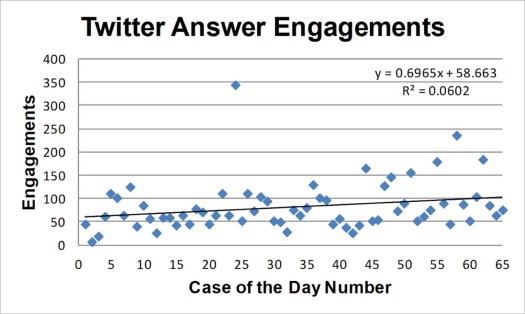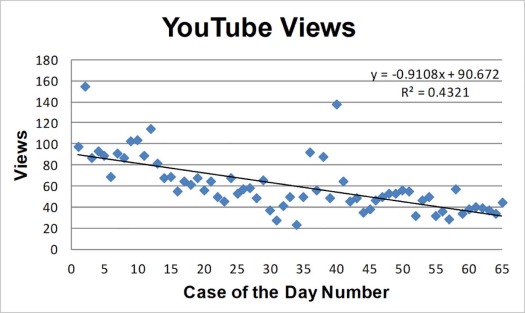Rationale and Objectives
We report the development of a new “Case of the Day” (COTD) educational initiative using email, social media (SoMe), and a website to disseminate content, as well as its trends in viewership and assessment of utility for the first year of implementation.
Materials/Methods
Using an image-rich format, a new unknown case was disseminated to radiology trainees and attendings at our institution by email twice per week, including history, salient images, and follow-up questions. Simultaneously, content was externally disseminated on Twitter and a publicly viewable departmental website. On subsequent days, the answer was posted via email, Twitter, and website in the form of a brief YouTube video lecture. Viewership data were collected over the first 12 months (July 1, 2016 to June 30, 2017), and an anonymous survey of participants was performed.
Results
Sixty-five COTDs had complete viewership data and were included in our analysis, yielding 4911 “case” email views (mean = 76), 3798 “answer” email views (mean = 58), 68,034 “case” Twitter impressions (mean = 1047), 75,724 “answer” Twitter impressions (mean = 1164), 5465 “case” Twitter engagements (mean = 84), and 5307 “answer” Twitter engagements (mean = 82). COTD YouTube video lectures garnered 3657 views (mean = 61) amounting to 10,358 minutes of total viewing time. Viewers were very satisfied with COTD quality, with 97% ( n = 63) reporting the quality as “good” or “excellent.”
Conclusions
Email and SoMe can serve as effective tools for disseminating radiology educational content. SoMe offers substantial external visibility and branding potential for programs.
Introduction
The past decade has seen a dramatic increase in the utilization of social media (SoMe) for uses ranging from personal entertainment, work-related marketing, and education. According to a recent national survey by the Pew Research Center, a substantial number of American internet users now use SoMe, most frequently in the form of Facebook (79%; facebook.com , Menlo Park, CA), Instagram (32%; Instagram.com , Menlo Park, CA), Pinterest (31%; pinterest.com , San Francisco, CA), LinkedIn (29%; linkedin.com , Sunnyvale, CA), and Twitter (24%; twitter.com , San Francisco, CA) . As of 2015, 65% of the American adult population reported utilization of SoMe, a striking increase compared to the 7% utilization rate reported in 2005 . SoMe engagement is particularly high among the Millennial and Generation X generations, with 86% of US adults between ages 18 and 29 and 80% of US adults between ages 30 and 49 reporting SoMe use .
SoMe may be an ideal platform to deliver medical education. Already familiar to medical professionals who use it recreationally , SoMe has a large built-in audience of pre-existing users. As a networking tool, SoMe transcends departmental, institutional, and even international boundaries, allowing learners to build valuable personal and professional relationships with other users. Importantly, the mainstream SoMe applications (apps), such as Facebook, Twitter, and Instagram, are free to download and work universally across various mobile and tablet platforms, regardless of operating system. Easy access to participation in this technology, a key ingredient to the success of all SoMe, is vital to the way that free open-access medical education allows educators to generate and instantly share content with so many users worldwide , a practice which is highly valued by the current generation of learners . Lastly, through apps such as YouTube (Alphabet, Inc., San Bruno, CA), educational content can not only be disseminated worldwide, but also archived in perpetuity for the benefit of future learners.
Get Radiology Tree app to read full this article<
Get Radiology Tree app to read full this article<
Get Radiology Tree app to read full this article<
Materials and Methods
Get Radiology Tree app to read full this article<
Educational Tool and Education Initiative Overview
Get Radiology Tree app to read full this article<
Get Radiology Tree app to read full this article<
Get Radiology Tree app to read full this article<
Content Design
Get Radiology Tree app to read full this article<
TABLE 1
Case of the Day Content
Subspecialty Number Abdominal/GI 6 Cardiothoracic 1 Emergency Radiology 2 Interventional Radiology 1 Musculoskeletal 1 Neuororadiology—Brain 8 Neuroradiology—Head and Neck 37 Neuroradiology—Spine 3 Nuclear Medicine 5 Pediatric Radiology 1
Content Source Attending Radiologist Alone 19 Mentored Trainee 46
Get Radiology Tree app to read full this article<
Get Radiology Tree app to read full this article<
Content Dissemination
Get Radiology Tree app to read full this article<
Get Radiology Tree app to read full this article<
Get Radiology Tree app to read full this article<
Get Radiology Tree app to read full this article<
Get Radiology Tree app to read full this article<
Get Radiology Tree app to read full this article<
Data Collection
Get Radiology Tree app to read full this article<
Get Radiology Tree app to read full this article<
Get Radiology Tree app to read full this article<
Survey
Get Radiology Tree app to read full this article<
Get Radiology Tree app to read full this article<
Statistical Analysis
Get Radiology Tree app to read full this article<
Results
Email Viewership
Get Radiology Tree app to read full this article<
Get Radiology Tree app to read full this article<
Twitter Viewership
Get Radiology Tree app to read full this article<
Get Radiology Tree app to read full this article<
YouTube Viewership
Get Radiology Tree app to read full this article<
Get Radiology Tree app to read full this article<
Get Radiology Tree app to read full this article<
Get Radiology Tree app to read full this article<
Website Viewership
Get Radiology Tree app to read full this article<
Survey
Get Radiology Tree app to read full this article<
Get Radiology Tree app to read full this article<
Discussion
Get Radiology Tree app to read full this article<
Get Radiology Tree app to read full this article<
Get Radiology Tree app to read full this article<
Get Radiology Tree app to read full this article<
Get Radiology Tree app to read full this article<
Get Radiology Tree app to read full this article<
Get Radiology Tree app to read full this article<
Get Radiology Tree app to read full this article<
Get Radiology Tree app to read full this article<
Get Radiology Tree app to read full this article<
Get Radiology Tree app to read full this article<
Conclusion
Get Radiology Tree app to read full this article<
Acknowledgments
Get Radiology Tree app to read full this article<
Get Radiology Tree app to read full this article<
Appendix
Radiology Case of the Day
Year One Utilization Survey
Get Radiology Tree app to read full this article<
Get Radiology Tree app to read full this article<
Get Radiology Tree app to read full this article<
Get Radiology Tree app to read full this article<
Get Radiology Tree app to read full this article<
Get Radiology Tree app to read full this article<
Get Radiology Tree app to read full this article<
Get Radiology Tree app to read full this article<
Get Radiology Tree app to read full this article<
Get Radiology Tree app to read full this article<
Get Radiology Tree app to read full this article<
Get Radiology Tree app to read full this article<
Get Radiology Tree app to read full this article<
Get Radiology Tree app to read full this article<
Get Radiology Tree app to read full this article<
References
1. Greenwood S., Perrin A., Duggan M.: Social Media Update 2016. In Pew Research Center; Available at www.pewinternet.org/2016/11/11/social-media-update-2016/ Accessed September 25, 2017
2. Perrin A.: Social Media Usage: 2005–2015. In Pew Research Center; Available at www.pewinternet.org/2015/10/08/social-networking-usage-2005-2015/ Accessed September 25, 2017
3. Pew Research Center : Social Media Fact Sheet. In Pew Research Center; Available at www.pewinternet.org/fact-sheet/social-media/ Accessed September 25, 2017
4. Bosslet G.T., Torke A.M., Hickman S.E., et. al.: The patient-doctor relationship and online social networks: results of a national survey. J Gen Intern Med 2011; 26: pp. 1168-1174.
5. Klee D., Covey C., Zhong L.: Social media beliefs and usage among family medicine residents and practicing family physicians. Fam Med 2015; 47: pp. 222-226.
6. Pearson D., Cooney R., Bond M.C.: Recommendations from the Council of Residency Directors (CORD) social media committee on the role of social media in residency education and strategies on implementation. West J Emerg Med 2015; 16: pp. 510-515.
7. Galiatsatos P., Porto-Carreiro F., Hayashi J., et. al.: The use of social media to supplement resident medical education—the SMART-ME initiative. Med Educ Online 2016; 21: pp. 29332.
8. Carroll C.L., Bruno K., von Tschudi M.: Social media and free open access medical education: the future of medical and nursing education?. Am J Crit Care 2016; 25: pp. 93-96.
9. Grock A., Paolo W.: Free open access medical education: a critical appraisal of techniques for quality assessment and content discovery. Clin Exp Emerg Med 2016; 3: pp. 183-185.
10. Shah V., Kotsenas A.L.: Social media tips to enhance medical education. Acad Radiol 2017; 24: pp. 747-752.
11. Prabhu V., Rosenkrantz A.B.: Enriched audience engagement through twitter: should more academic radiology departments seize the opportunity?. J Am Coll Radiol 2015; 12: pp. 756-759.
12. Glover M., Choy G., Boland G.W., et. al.: Radiology and social media: are private practice radiology groups more social than academic radiology departments?. J Am Coll Radiol 2015; 12: pp. 513-518.
13. Ranschaert E.R., van Ooijen P.M., Lee S., et. al.: Social media for radiologists: an introduction. Insights Imaging 2015; 6: pp. 741-752.
14. Hoang J.K., McCall J., Dixon A.F., et. al.: Using social media to share your radiology research: how effective is a blog post?. J Am Coll Radiol 2015; 12: pp. 760-765.
15. Koontz N.A., Kamer A.P., Dodson S.C., et. al.: Social media utilization at an academic radiology practice. Acad Radiol 2017; Epub ahead of print
16. Zimmerman J.: What’s your organization’s “Outward Facing” social media strategy?. In: Skillsoft: Learning Re-imagined; Available at blogs.skillsoft.com/learning-re-imagined/2010/09/whats-your-organizations-outward-facing-social-media-strategy.html Skillsoft
17. Diug B., Kendal E., Ilic D.: Evaluating the use of twitter as a tool to increase engagement in medical education. Educ Health (Abingdon) 2016; 29: pp. 223-230.
18. Mostaghimi A., Olszewski A.E., Bell S.K., et. al.: Erosion of digital professionalism during medical students’ core clinical clerkships. JMIR Med Educ 2017; 3: pp. e9.
19. Sutherland S., Jalali A.: Social media as an open-learning resource in medical education: current perspectives. Adv Med Educ Pract 2017; 8: pp. 369-375.
20. El Bialy S., Jalali A.: Go where the students are: a comparison of the use of social networking sites between medical students and medical educators. JMIR Med Educ 2015; 1: pp. e7.
